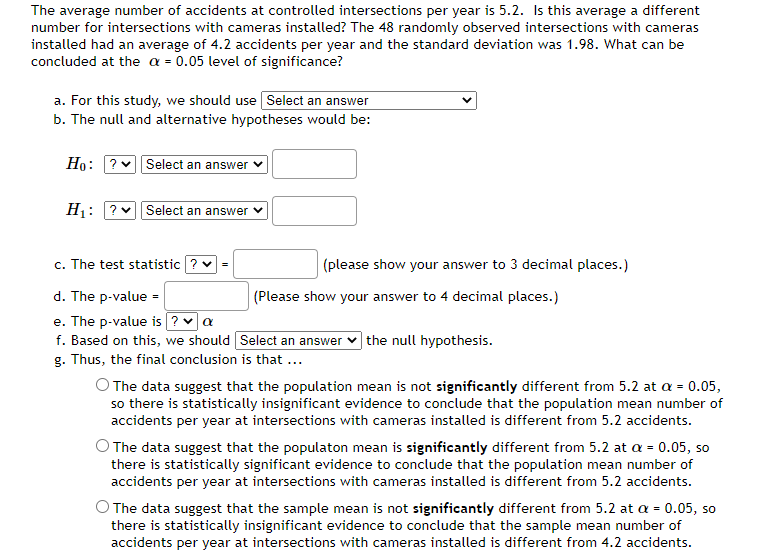The average number of accidents at controlled intersections per year is 5.2. Is this average a different number for intersections with cameras installed? The 48 randomly observed intersections with cameras
The average number of accidents at controlled intersections per year is 5.2. Is this average a different number for intersections with cameras installed? The 48 randomly observed intersections with cameras
MATLAB: An Introduction with Applications
6th Edition
ISBN:9781119256830
Author:Amos Gilat
Publisher:Amos Gilat
Chapter1: Starting With Matlab
Section: Chapter Questions
Problem 1P
Related questions
Question

Transcribed Image Text:The average number of accidents at controlled intersections per year is 5.2. Is this average a different
number for intersections with cameras installed? The 48 randomly observed intersections with cameras
installed had an average of 4.2 accidents per year and the standard deviation was 1.98. What can be
concluded at the a = 0.05 level of significance?
a. For this study, we should use Select an answer
b. The null and alternative hypotheses would be:
Ho: ? Select an answer
H₁:
?✓ Select an answer ✓
c. The test statistic ? ✓
d. The p-value=
e. The p-value is ? ✓ a
f. Based on this, we should
g. Thus, the final conclusion is that ...
(please show your answer to 3 decimal places.)
(Please show your answer to 4 decimal places.)
Select an answer the null hypothesis.
O The data suggest that the population mean is not significantly different from 5.2 at a = 0.05,
so there is statistically insignificant evidence to conclude that the population mean number of
accidents per year at intersections with cameras installed is different from 5.2 accidents.
O The data suggest that the population mean is significantly different from 5.2 at a = 0.05, so
there is statistically significant evidence to conclude that the population mean number of
accidents per year at intersections with cameras installed is different from 5.2 accidents.
The data suggest that the sample mean is not significantly different from 5.2 at a = 0.05, so
there is statistically insignificant evidence to conclude that the sample mean number of
accidents per year at intersections with cameras installed is different from 4.2 accidents.
Expert Solution
This question has been solved!
Explore an expertly crafted, step-by-step solution for a thorough understanding of key concepts.
Step by step
Solved in 5 steps

Recommended textbooks for you

MATLAB: An Introduction with Applications
Statistics
ISBN:
9781119256830
Author:
Amos Gilat
Publisher:
John Wiley & Sons Inc

Probability and Statistics for Engineering and th…
Statistics
ISBN:
9781305251809
Author:
Jay L. Devore
Publisher:
Cengage Learning

Statistics for The Behavioral Sciences (MindTap C…
Statistics
ISBN:
9781305504912
Author:
Frederick J Gravetter, Larry B. Wallnau
Publisher:
Cengage Learning

MATLAB: An Introduction with Applications
Statistics
ISBN:
9781119256830
Author:
Amos Gilat
Publisher:
John Wiley & Sons Inc

Probability and Statistics for Engineering and th…
Statistics
ISBN:
9781305251809
Author:
Jay L. Devore
Publisher:
Cengage Learning

Statistics for The Behavioral Sciences (MindTap C…
Statistics
ISBN:
9781305504912
Author:
Frederick J Gravetter, Larry B. Wallnau
Publisher:
Cengage Learning

Elementary Statistics: Picturing the World (7th E…
Statistics
ISBN:
9780134683416
Author:
Ron Larson, Betsy Farber
Publisher:
PEARSON

The Basic Practice of Statistics
Statistics
ISBN:
9781319042578
Author:
David S. Moore, William I. Notz, Michael A. Fligner
Publisher:
W. H. Freeman

Introduction to the Practice of Statistics
Statistics
ISBN:
9781319013387
Author:
David S. Moore, George P. McCabe, Bruce A. Craig
Publisher:
W. H. Freeman